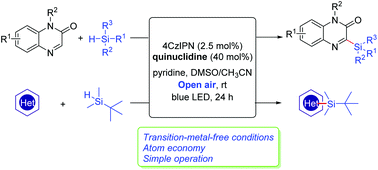Organic photoredox catalyzed C–H silylation of quinoxalinones or electron-deficient heteroarenes under ambient air conditions†
Abstract
Direct C–H silylation of quinoxalinones was achieved by the combination of organic photoredox catalysis and hydrogen atom transfer (HAT) under ambient air conditions. Transition metal- and external oxidant-free conditions were the major features of this protocol. A series of silylated quinoxalinones with broad functional groups had been synthesized in moderate to high yields. This methodology was also applicable for the C–H silylation of some electron-deficient heteroarenes.



 Please wait while we load your content...
Please wait while we load your content...